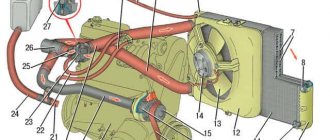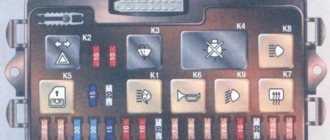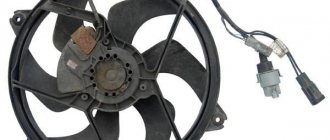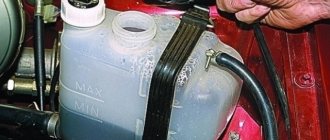An air lock in the engine cooling system is one of the main reasons for the engine taking a long time to warm up to operating temperature. Therefore, every driver should be interested in removing air lock from the cooling system of his car.
How to properly remove an air lock from the cooling system?
According to the law of physics, air accumulates in the highest place. In a car, the highest link in the coolant chain is the throttle body. That is why the air must be removed from there. There are several ways to get rid of an air lock. Here's the first one from the bottom:
If you have a 1.6 liter engine, then the first step is to remove the plastic cover on the engine - unscrew the cover on the engine to fill the oil, and then pull out the entire cover. It is seated on rubber seals. After removing this plastic screen, screw the oil cap back on to prevent dirt from getting into the crankcase.
- We find the heating pipes for the throttle assembly (there are 2 of them), see the figure. Pick up any phone
- Next, unscrew the cap of the expansion tank (coolant reservoir) and cover the neck of the tank with a clean rag.
- We begin to blow into the tank with liquid. We blow until all the air comes out of the hose and antifreeze flows out.
- We quickly put the tube back on and tighten it with a clamp so that no air gets in.
(It is worth noting that depending on the tube that you removed, antifreeze may leak from both the tube and the fitting from which the tube was removed)
The second method of removing air from the cooling system is less perverted. There is no need to blow anything here:
- Warm up the engine to operating temperature
- Warm up, turn off the engine
- The expansion tank cap does NOT need to be unscrewed.
- As in the first method, unscrew the clamp of the coolant pipe on the throttle assembly.
- Having removed the heating pipe of the throttle assembly, release the air, and after the antifreeze begins to flow out, immediately put it back on the fitting and secure it well with a clamp.
But be careful and careful! Don't forget that the coolant temperature is approximately 90 degrees.
There is also a simpler, but less effective way to eliminate an air lock:
1) We drive up a steep hill so that the radiator cap becomes the highest point of the cooling system.
2) Unscrew the cap of the expansion tank and the radiator cap.
3) Let the car warm up to operating temperature
4) Then we accelerate several times and at the same time add coolant into the barrel.
Do this until bubbles stop appearing.
How to remove an air lock on a VAZ with electronic (e-gas)?
Since there is no throttle valve cooling system, you need to bypass this unit. Here you can also set the car up.
I hope that these three methods will help you solve the problem, and that you have found all the answers to your questions on the topic “How to get rid of an airlock?”
An air lock in a car's cooling system can cause problems in the operation of the engine, electronic sensors, thermostat and other mechanisms. Next, we’ll figure out how to solve the problem yourself.
FEATURES OF ENGINE COOLING VAZ 2114
This car, like the VAZ 2113 and VAZ 2115, uses a VAZ closed liquid cooling system, the coolant in which is antifreeze or antifreeze. The coolant circulates through special channels in a running engine. Its circulation is ensured by a pump, which is driven by the engine crankshaft using a drive belt.
It regulates the flow of coolant, its direction, by a device called a thermostat. It is designed in such a way that before the coolant warms up to operating temperature, it circulates in a small circle, bypassing the radiator. When the liquid reaches a temperature of 87 0 C, it opens and the liquid flow is directed to the radiator for cooling.
The radiator is blown by a flow of oncoming air, and when there is not enough air, an electric fan turns on. For these purposes, a sensor is installed in the radiator, which produces a signal to turn it on. Also, hot liquid flows through the heater radiator and heats the interior of the car in cold weather. Excess antifreeze from thermal expansion is collected in an additional tank, which is called an expansion tank.
Air lock VAZ 2114 and what to do with it
Welcome, friends, to the DIY car repair website. The main task of the cooling system is to reduce the temperature of the main parts of the power unit, gases and oil as quickly as possible, as well as protect the engine from overheating.
How to remove air from the cooling system
Coolant (antifreeze, antifreeze) passes through special channels, picking up heat and cooling in the system radiator. But the efficiency of the system may be impaired if there is an air lock in the cooling system.
In today's article we will look at various ways to expel air from the cooling system, as well as the causes and malfunctions of air locks.
Causes and symptoms of malfunction
The appearance of air jams is a common problem for experienced car enthusiasts, which they often encounter. But before you remove air from the cooling system, it is still advisable to know the cause of the malfunction.
There are several of them:
- Errors when adding coolant or replacing it.
- Suction at the junction of pipes.
Similar problems in 90% of cases occur in winter, when the fittings decrease in size under the influence of low temperatures.
As a result, microcracks or other types of damage appear, through which excess air leaks;
- Atmospheric valve defect;
- pump depressurization;
- the appearance of leaks in radiators (cooling or heating);
- damage to the gasket under the cylinder head (white smoke appears from the exhaust pipe, oil leakage from under the cylinder head becomes noticeable);
- thermostat failure;
- mechanical defects or clogging of radiators (pipes connecting them).
The presence of an air lock in the cooling system can be easily diagnosed; the engine takes a long time to warm up or, conversely, does not reach the required temperature at all.
It's easy to explain. Due to strong airiness, antifreeze (antifreeze) cannot properly enter the cooling radiator. As a result, the engine temperature constantly increases.
The consequences can be catastrophic, especially in winter. The heater (stove) does not work. In this case, the coolant no longer enters the heater radiator and, as a result, it does not warm up.
In any of the above cases, it may be necessary to remove air from the cooling system. But how to do it right?
Three methods for removing air from the cooling system
Let's look at the main and most effective ways to solve the problem.
Method number 1 . Proceed in the following sequence:
Remove the plastic casing that is installed on the engine. To do this, you will need to unscrew the cap on the hole for adding oil. After this, remove the cover (once the casing has been removed, the cover can be returned to its place to prevent dirt and dust from getting inside the power unit).
Find the pipes that are responsible for heating the throttle assembly. Select any one and pull it off. Unscrew the cap from the hole in the expansion tank that contains the antifreeze and cover the hole with a clean rag.
Blow inside the tank. In this way, pressure is created that squeezes out the air. As soon as coolant comes out of the pipe, you have successfully gotten rid of the air.
Return the handset to its place (the sooner you do this, the better). Otherwise, you can catch a portion of air again.
Method number 2. This option is much simpler and you don’t need to blow anywhere. Vent the air as follows:
- Warm up the engine for 10-15 minutes and then turn it off;
- the cap on the expansion tank remains screwed on;
- also (as in the previous method) remove one of the pipes on the throttle assembly;
- wait until coolant comes out of it.
As soon as this happens, immediately return the tube to its place and secure it tightly with a clamp.
When performing this operation, be very careful, because the temperature of antifreeze (antifreeze) can reach 80-90 degrees Celsius.
Method number 3. We cannot mention another simple but very effective method of getting rid of air in the cooling system.
Proceed like this:
- Find a steep hill and stand on it so that the front of the car is the highest point;
- put the car on the handbrake and place stands under the wheels to prevent accidental rolling;
- unscrew the plugs from the radiator and expansion tank;
- start the car and let it warm up for 10-15 minutes;
- Press the accelerator pedal periodically and add coolant to the reservoir as needed.
Continue adding until no bubbles appear at all. Only in this case can the work be considered completed.
Now you know how to remove an air lock from the cooling system quickly and without special financial costs.
At first glance, this problem may seem minor, but in the long run it can lead to a whole host of problems.
So, when the first symptoms of airiness appear, ruthlessly expel the air pockets and open normal access for coolant circulation.
Good luck on the roads and of course no breakdowns. Don’t forget to share your personal experience in repairing VAZ cars in the comments.
PRESENCE OF AIR IN THE SYSTEM
Air in the engine cooling system is an unacceptable phenomenon. Heat exchange processes in the motor are disrupted, which can cause it to overheat, thereby creating the preconditions for failure. In cold weather, there will be no heating of the car interior or body glazing. Sensors installed in injection engines begin to provide distorted information to the electronic control unit, which disrupts the engine’s operating cycle.
WHY DO AIR LOCKES OCCUR?
In order for an air lock to occur in the cooling system, one of several possible reasons for its occurrence is sufficient. These may be such violations in the operation of the system:
How to remove air from the heating system of a VAZ, air in the stove Repair and service
Author KakSimply!
With the onset of cold weather, many owners of VAZ cars have problems with the operation of the heating system. In this case, the stove either heats poorly or does not heat at all, and cold air blows from it. A possible cause of the malfunction may be an air lock in the heating system.
You will need
- — instructions for repairing a VAZ car;
- — coolant: antifreeze or antifreeze.
Instructions
To make sure that the cause of the heater malfunction is an air lock, try the heater radiator - in this case it should be hot. If this is not the case, look for a breakdown elsewhere.
After making sure that there is air in the heating system, try to drive your front wheels onto some hill, hill or overpass and leave the engine idling at medium speed for several minutes.
If the previous method did not produce results, disconnect the pipe from the throttle assembly, which goes to the return line. Fill the reservoir with antifreeze or antifreeze. If the coolant immediately runs out of the fitting of the throttle body pipe, then plug the fitting and hold until the antifreeze runs out of the hose.
If the fluid does not flow out immediately, start the VAZ and close the hose with your finger. Wait until coolant flows out of the pipe. After the work has been done, put the pipe back on and loop it. Warm up the internal combustion engine to operating temperatures and check the stove.
After filling the system, press all the hoses well and screw the expansion tank cap as tightly as possible. This will prevent coolant, which has expanded after heating, from flowing out of the holes left, and air bubbles from penetrating inside the expansion tank.
Rapid filling of the heating system with water often causes the formation of air locks: gas bubbles enter the utilities along with the water. There are several ways to remove air accumulated in the heating network.
You will need
- - pressure gauge
- - locksmith's tool
Instructions
Video on the topic
https://youtube.com/watch?v=P7lB2DtGd2w
note
Monitor the water pressure in the heating system. A drop in readings may indicate a leak, and uneven temperature conditions in the radiators may indicate the presence of air pockets. If the filling is slow and the heating system is started correctly, the deaeration procedure will not take much time.
Helpful advice
The heating system on one floor fills up in an hour on average. The duration depends on the structure and length of the communication: the more extensive it is, the more time it will take.
An article about you, published in the online magazine “We Build It Yourself.”
Video on the topic
https://youtube.com/watch?v=A4UXEZxXzOI
note
Problems with the heater may directly relate to the engine cooling system. The stove does not warm up if the coolant level in the expansion tank is low. Check carefully to see if there is an antifreeze leak in the system. If this is the case, fix this problem as quickly as possible, otherwise all your efforts will be wasted and the air lock will reappear in place of the escaped fluid.
Helpful advice
If after these manipulations the stove is still warm and not hot, repeat the procedure, adding more coolant to the normal level.
- Repair of stove (heater) VAZ 2110
- plug in the stove
Is the advice useful?
How to remove air from the heating system of a VAZ
Didn't get the answer to your question? Ask our expert:
Signs of air in the engine cooling system
How can you tell if something is wrong with your car’s cooling system? The first thing you should do is listen to how it works and simply inspect it visually. We have identified the main symptoms of malfunctions:
- The pump makes a lot of noise when operating. If it begins to fail and some structural elements break, then it makes loud sounds during operation.
- Antifreeze leak. If there is a defect somewhere in the system, then an antifreeze leak can be easily detected even without a magnifying glass. Carefully inspect the engine and chassis of the car; stains from dried or fresh coolant will be visible on it.
- The stove is malfunctioning. Of course, there are a huge number of reasons why the stove may work poorly or stop heating altogether. But malfunctions can also occur due to the fact that there is an air lock in the system. A more detailed examination is needed here.
- Difficulties in the operation of the thermostat. When the CO (cooling system) activates extremely quickly after starting, it is most likely due to the fact that the thermostat is broken. In almost 80% of cases, malfunctions occur precisely because of a thermostat failure. Also, the thermostat may stop working if air gets into the pipes. Then the following happens - the valve is not constantly closed due to a small air lock, and therefore the antifreeze circulates only in a small circle. If you find that the engine is already very hot, then there are only two reasons: the thermostat has broken or it has become airy.
If you determine that at least one of the above signs suits you, then you need to conduct a full diagnostics of the CO at a car service center as soon as possible. But before that, you still need to determine the reasons, since many of them can be eliminated with your own hands.
Liquid pump (pump)
On a VAZ 2114 car, the engine cooling system works due to the fact that the antifreeze is in motion and under pressure higher than atmospheric pressure. The movement is created using a pump installed on the right wheel side directly in the engine block. Driven by a timing belt. Examination:
- Drain the antifreeze from the system (there are two holes for this). This should only be done on a cooled engine!
- Unscrew the three bolts securing the plastic cover to the engine block.
- Use a key set to “17” to loosen the roller nut. This allows the timing belt to loosen.
- Remove the belt and look at its condition. If it is “eaten” from the outside (by 1-3 mm), then this indicates that the belt is slipping due to the pump being worn out.
- Take the pump pulley with your hands and try to move it, rotate it in different directions. If there is play or jamming, the pump must be replaced. Otherwise, the cooling system of the VAZ 2114 (injector or carburetor, it doesn’t matter at all) will not work correctly.
Causes of airlock
The main reason for this inconvenience is a mechanical violation of the tightness of the system or a breakdown of one of the units, leading to a violation of the tightness.
Therefore, when diagnosing it, pay attention to:
- the density of clamps on pipes and hoses, especially in winter, when materials are compressed;
- serviceability of the radiator cap and expansion tank valve;
- integrity of radiators (main and heating);
- the tightness of the pump and the integrity of its impeller;
- Thermostat serviceability;
- mechanical damage or clogging of the system of pipes and other flow channels of the SOD with foreign bodies.
Burnt engine gasket











